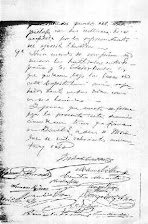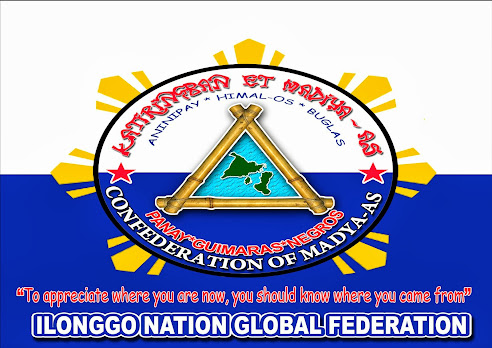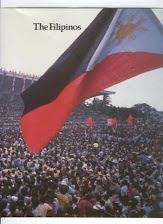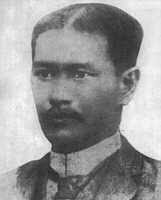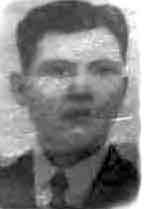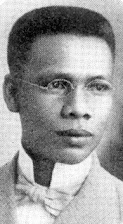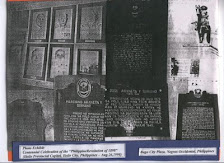 |
| Graciano Lopez-Jaena |
A TALE OF TWO LOPEZ CLANS OF JARO-ILOILO
(By: dinggol araneta divinagracia - Ilonggo Nation Global Federation - April 5, 2015)
Prologue:
In the Philippines today, whenever people speak of "Familia Lopez", what first comes to mind is the affluent Lopez'es of Panay and Negros that has become a semblance of enormous wealth and political power, of vested interest and corporate greed, and of the oligarchy.
However, it would be fair to add, that many prominent Lopez family are sincerely dedicated and truly committed with philantropic activities for love of God; while others, were directly involved in the fight for freedom and democracy for love of country.
Unknown to many, the clan began in Salog, now Jaro in Iloilo with two Lopez proginators that were not blood related, thus:
Early History * Genealogy
The Maximo Lopez Clan
At the turn of the 19th century during the Spanish era or "Tiempo Español", Maximo Lopez who became the patriarch of the original Lopez clan of Salog (now Jaro) in Iloilo married Juana Hilaria. They had two sons; Fermin and Placido. Fermin married Fernanda Hechanova and they had 12 children while Placido who married Maria Jacobe Jaena had 6 children. Placido doing odd jobs as general repairman and Maria a simple seamstress had a son named Graciano Lopez-Jaena, who eventually would became the national hero of the Ilonggo Nation . .
". . . On December 18, 1856, Graciano Lopez-Jaena was born in Jaro, Iloilo City. History recognized him as the first reformist and the acknowledged "Trailblazer" of the First Propaganda Movement. At age 18, he wrote “Fray Butod” that exposed the abuses and unholy alliance between Spanish authorities, abusive encomienderos and the immoral friars under the pseudonym “Jose Butete.”
He went to Spain in 1880 where together with Dr. Jose P. Rizal who arrived in 1882 and, later, Marcelo H. del Pilar, they constituted the triumvirate that became the core of propagandists and pamphleteers advocating reforms in the Philippine Archipelago. In February 1889, Lopez Jaena founded the "La Solidaridad" that became the mouthpiece of the propaganda movement that advocated reforms and with the novels of Rizal, “Noli Me Tangere” and “El Filibusterisimo” and the execution of the three Filipino priests, Gomez, Burgos and Zamora became the sparkplugs that ignited the Philippine Revolution of 1896. . . "
On the other hand, Maximo and Juana Hilaria-Lopez' eldest son Fermin who married Fernanda Hechanova were the parents of Eustaquio Hechanova Lopez who later acquired large tracts of land and settled in Silay, Negros Occidental. The Barangay E. Lopez in Silay City used to be one of his Haciendas in Negros. Don Eustaquio financed his first cousin Graciano's trip to Spain in 1880 that would change the course of Philippine history.
Don Eustaquio Hechanova Lopez, first married Justina Aplasca in Jaro by whom he had a son named Roque Aplasca Lopez. When the Don became a widower, he remarried for the second and later for the third time in Negros.
Meanwhile, Roque A. Lopez who remained in Iloilo, later joined the "Comite de Conspiradores" of Molo and expended his inheritance to finance the revolution and to support families of poor Ilonggo revolutionary forces.
". . .The "Comite de Conspiradores" initiated by Don Francisco Felipe Villanueva and headed by Don Raymundo Angulo Melliza was formed in Parian, now Molo in Iloilo on March 18, 1898. The initial members were "Parianons" that included; Pablo Araneta, Fernando Salas, Francisco Soriano, Jovito Yusay and from Jaro; Roque Lopez and Simon Ledesma. This became the nucleus that started the highly disciplined and well organized covert revolutionary movement in the Island of Panay. Five months later, together with the revolutionary leaders outside the City led by Martin Teofilo Delgado y Bermejo of Sta. Barbara, they formed a revolutionary government and thus, the "Estado Federal de Bisayas" was established. Thereafter, Gen. Roque Aplasca Lopez was elected President of the Assembly. . ."
It is regretable, indeed, that there is no street named nor a historical marker installed to honor Gen. Roque A. Lopez, the Ilonggo patriot and first President of the "Estado Federal de Visayas" and many more Ilonggo leaders, who won the revolution against Spanish colonization, thereby achieved the status as a truly independent and legitimate sovereign nation before the "Faux pas" of U.S. invasion in 1899 of the Ilonggo Nation.
Whereas, our City's main thoroughfares were named to honor our forebears adversaries and the revolucionary losers from Luzon. (Brgy. & Gen. Hughes St. , Gen. Luna St. , Bonifacio, J.M.Basa Street, etc., etc...). Likewise, Ilonggo Illustrados who collaborated with the early American regime.
The Basilio Lopez Clan
During the early 1800's, a childless wealthy Spaniard from Batangas surnamed Lopez, decided to settle in Iloilo because of the peace and order situation and economic potentials. With him was his young aide, a local Sino-Indio or "Mestizo de Sangley" that he raised as his own son. When the old man died, his young protege named Basilio that he allowed to carry his surname "Lopez" soley inherited his huge fortune. The young Basilio later married Sabina, the daughter of a trusted laundry woman of the wealthy "Familia Jalandoni" of Jaro. She too was allowed to use the surname "Jalandoni" and later inherited a substantial portion of her adoptive parents properties.
Basilio and Sabina Jalandoni-Lopez had 16 children. The eldest son Eugenio Jalandoni Lopez, who rose as a big-time industrialist and one of the wealthiest man in Jaro, also became the Gobernadorcillo of the Principalia de Jaro.
" . . . Earlier, Capitan Martin Delgado of Sta. Barbara together with Pedro Monteclaro of Miag-ao, Adriano Hernandez of Dingle, Quintin Salas of Dumangas and others led the volunteer battalion of Ilonggo contingents under the Spaniards who fought against Gen. Aguinaldos forces in Cavite and Pampanga. These military expeditions were mostly financed by Iloilo’s elite; more notably, Gobernadorcillo of Salog (Jaro) Don Eugenio Jalandoni Lopez and Don Felix de la Rama of Parian (Molo).
Later, however, Capitan Martin, with others, conspired for the Visayans instead of supporting the Spanish cause and organized an armed and open rebellion against the Spanish authorites in Panay. Several Visayan Generals including Gen. Raymundo Melliza and Gen. Pablo Araneta chose Delgado as "General en Jefe de los Tropas del Ejercito Libertador de Visayas y Governador Politico-Militar” based in Sta. Barbara, Iloilo. . ."
Don Eugenio Jalandoni Lopez married Marcela Felipe Villanueva, while his younger brother Marcelo Jalandoni Lopez also married her sister Julieta. They were the sisters of Francisco Felipe Villanueva (married to Sofia Conlu), who initiated the founding of the "Comite de Conspiradores" of Molo and the children of Don Eusebio and Maria Felipe de Villanueva.
Don Eugenio and Dña Marcela Villanueva-Lopez had sooo many children but were all relatively successful in their respective fields of endeavor. Their son Benito was assassinated while serving as Provincial Governor of Iloilo. He was married to Presentacion Javelona Hofileña, while his younger brother Vicente also married the sister named Elena Javelona Hofileña and they built the famous elegant mansion in Jaro known as "Nelly Garden".
When Gov. Benito V. Lopez was slain, his eldest son Eugenio "Eñing" was only 7-years old and brother Fernando "Nanding" even younger. But as destined by fate; Eñing and Nanding, with family financial backing, inherent business acumen and political savvy would emerged as the most powerful brothers in the country.
" . . . The ABS-CBN Network was initiated in the late 1920’s by the family of Gov. Benito V. Lopez and Presentacion J. Hofileña who founded --The Times “El Tiempo” in Calle Ortiz, Iloilo City. This became the most popular newspaper in Western Visayas during the 1930‘s..
This print media venture blossomed into national prominence when in the year 1947 the Lopez'es acquired the Chronicle Group. Later when the mother company; Benpres Holdings was established --they expanded into power generation and distribution; road and water infrastructure, etc..
When the new phenomenon, "tele-vision" came into the picture; the inherent business acumen and foresight of Don Eugenio “Eñing” Lopez, proved his worth and the family controlled Television Giant was born.
That was the era when foreign Head-of-States and even Middle Eastern and European Royalties were amazed by the champagne "Fountain" flowing and wealth flaunting parties hosted by extravagant modern day Sugar Barons, led by “Don Eñing” who controls Philippine economy and his brother Vice President Fernando “Toto Nanding” Lopez who holds the reign in the political arena. Yes! even Malacañang tiptoed and was cautious not to offend the powerful Sugar Block.
During the Martial Law years, the Lopez family business interests; that included Meralco and ABS-CBN were confiscated by the government. In 1986, thousands of Metro Manilan's staged a relatively peaceful People's Power Revolution led by the elite and under the guidance of the Catholic Church heirachy --they succeeded. Thus, Oligarchy was restored.
Thereafter, President Corazon Cojuangco Aquino returned to the Lopez'es their business empires under a sweetheart deal, while the Lady President's own “Kamag-anak. Inc.” enjoyed the fruits of the EDSA-I revolt.
With the advent of cable technology and cyberspace communication, even Filipinos abroad could now easily view Pinoy Channels --dominated by the Lopez family from Iloilo . . ."
Epilogue:
Although this illustrious family of Jaro began centuries ago from two different bloodlines with the same surname, in later years the offsprings inter-married that nowadays, many consider themselves as one big happy "Lopez" family.
Acknowledgement for invaluable testimonials of two prominent members that belong to each of the Lopez clan, who prefer to remain anonymous.
Captions in italic were based from "The Rise & Fall of the Federal Republic of the Visayas at: http://ilonggonation.blogspot.com/p/rise-and-fall-of-federal-republic-of.html
~~~~~~~~~~~~~~~~~~~~~ oo0oo ~~~~~~~~~~~~~~~~~~
